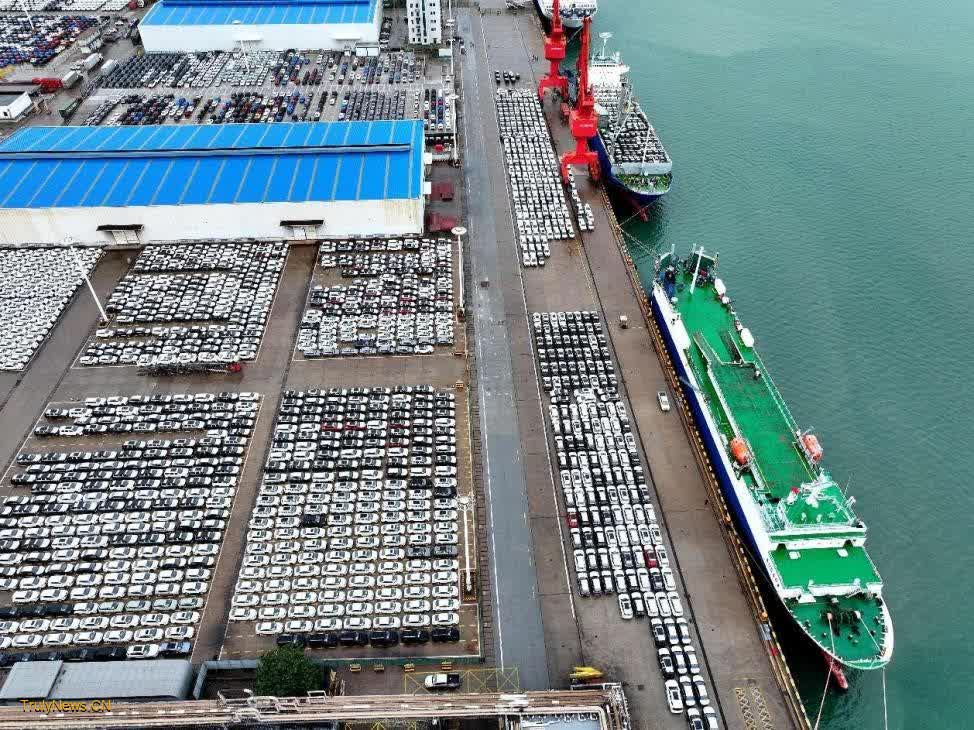
Containers are handled at a container terminal of Ningbo-Zhoushan Port, east China’s Zhejiang province. (People’s Daily Online/Tang Jiankai)
Maritime transport is the lifeline of global trade, as it handles over 80 percent of the international movement of goods.
According to the Analysis Report on Operation of Chinese Ports 2024 (hereafter referred to as “the Report”) released by the Transport Planning and Research Institute, China’s Ministry of Transport, the volume of China’s foreign trade via maritime transport accounted for 30.1 percent of global marine shipping in 2023, up 2.2 percentage points year on year.
Driven by the recovery of demand for foreign trade and the restructuring of the global trade system, China’s foreign trade via marine shipping experienced rapid growth. In 2023, Chinese coastal ports handled 4.96 billion tons of foreign trade cargo, a year-on-year increase of 9.6 percent.
Containers, coal, metallic minerals, mineral building materials and petroleum make up the five major categories of cargo handled by Chinese coastal ports, accounting for 84 percent of the total throughput of all coastal ports in 2023. In particular, the throughput of imported coal and crude oil went through rapid growth, while that of imported iron ores remained at a high level.
While maintaining rapid growth, the structure of China’s foreign trade via marine shipping has continuously improved. In 2023, containers were responsible for transporting 23.3 percent of foreign trade cargo by sea in China, 0.2 percentage points higher from a year ago, maintaining steady growth year by year. Now, with the upgrading of customs clearance services at major Chinese coastal ports, exporters now find it easier to ship their cargo overseas via containers.
For instance, Yiwu Customs, east China’s Zhejiang province, has established a special window at Yiwu Port for the UEFA European Championship, offering targeted guidance to sports-related enterprises. It has enabled “one-click declaration,” allowing over 99 percent of export goods purchased via the market to be released by computer review almost instantly.
Besides, intelligent surveillance systems have been installed at the Yiwu West Railway Station, allowing for automatic container entry and inspection without the need for box opening.

Vehicles to be exported are being loaded onto a roll-on/roll-off ship at a terminal in Lianyungang, east China’s Jiangsu province. (People’s Daily Online/Wang Chun)
At Ningbo-Zhoushan Port, Zhejiang province, Ningbo Customs has leveraged blockchain technology for authentication and traceability of bulk cargo, resulting in a significant boost in clearance efficiency. This has driven the loading efficiency of new energy vehicles to spike from 180 units to 1,000 units per day.
If maritime transport serves as the lifeblood of China’s foreign trade, ports are the vital nodes along these crucial pathways.
Rizhao city, east China’s Shandong province, boasts an extensive reach of rail transportation. One rail route starting from Rizhao Port stretches westward, entering Kazakhstan through Alashankou, northwest China’s Xinjiang Uygur autonomous region, then continuing through Russia, Belarus, Poland, and Germany before reaching the port of Rotterdam in the Netherlands – a journey spanning over 10,000 kilometers.
Recently, Rizhao Port has been approved to launch international multimodal transport services for transit goods, which means that cargo shipped to Rizhao Port from across the world by sea can be transported by rail to Mongolia, Russia, the Democratic People’s Republic of Korea, Vietnam and Central Asian countries.
China’s major coastal ports are experiencing rapid growth in cargo throughput, with many ports seeing an annual growth rate of over 10 percent.
According to the Report, 23 Chinese coastal ports reported cargo throughput of over 200 million tons in 2023. Among them, Ningbo-Zhoushan Port took the lead with a throughput of 1.32 billion tons.
Behind this enormous throughput lie the continuously strengthened overall maritime support and infrastructure capabilities of China’s coastal ports. China has established the world’s largest maritime support and infrastructure system.

Foreign vessels carrying containers depart from a port in Rongcheng, east China’s Shandong province, for their destinations overseas. (People’s Daily Online/Li Xinjun)
According to data released by China’s Ministry of Transport, from 2013 to 2023, the number of navigational marks along China’s coast increased by 68.8 percent to 20,600, all of which can be remotely monitored and controlled using the BeiDou Navigation Satellite System (BDS).
The advancement of charting services has resulted in comprehensive coverage of electronic charts along China’s coast, and these electronic charts can be published online and updated in real time. In 2023, 4.92 million copies of electronic coastal charts were issued in China.
Besides, China has established a coastal ground-based augmentation system enabled by the BDS, which consists of 23 BDS differential stations and 75 BDS continuously operating reference stations. The system provides centimeter-level high-precision navigation and positioning services.
Furthermore, China has built a maritime safety communications network, which serves as an integral part of the Global Maritime Distress and Safety System, offering communications services for maritime distress situations.
China is also actively promoting the development of 4G and 5G infrastructure and satellite communications applications, continuously enhancing the capabilities of satellite broadband data communications.
According to the Report, the cargo throughput of China’s coastal ports and the country’s foreign trade via marine shipping will continue to maintain steady growth. The total foreign trade cargo throughput of coastal ports in China is expected to reach around 5.1 billion tons this year, a year-on-year growth of about 3.2 percent.
Li Qing, deputy head of the China Waterborne Transport Research Institute under the Ministry of Transport, said that China will continue to accelerate the application of artificial intelligence, 5G, and big data technologies in the port and shipping industry, increase the port efficiency, promote the digital, intelligent, and green development of its coastal ports, and enhance the overall capabilities of ports.